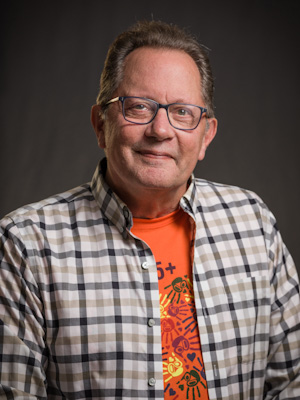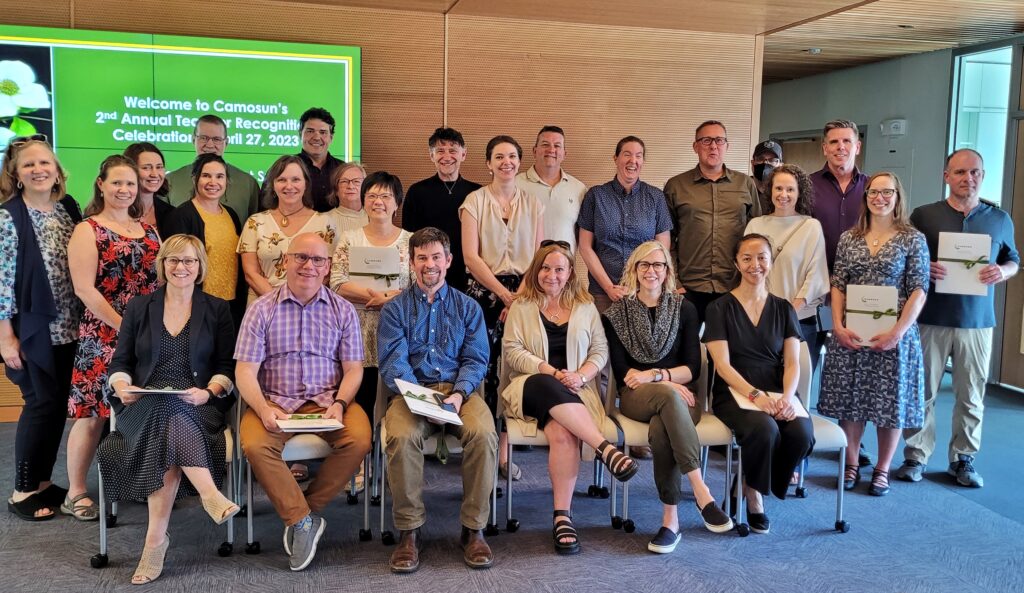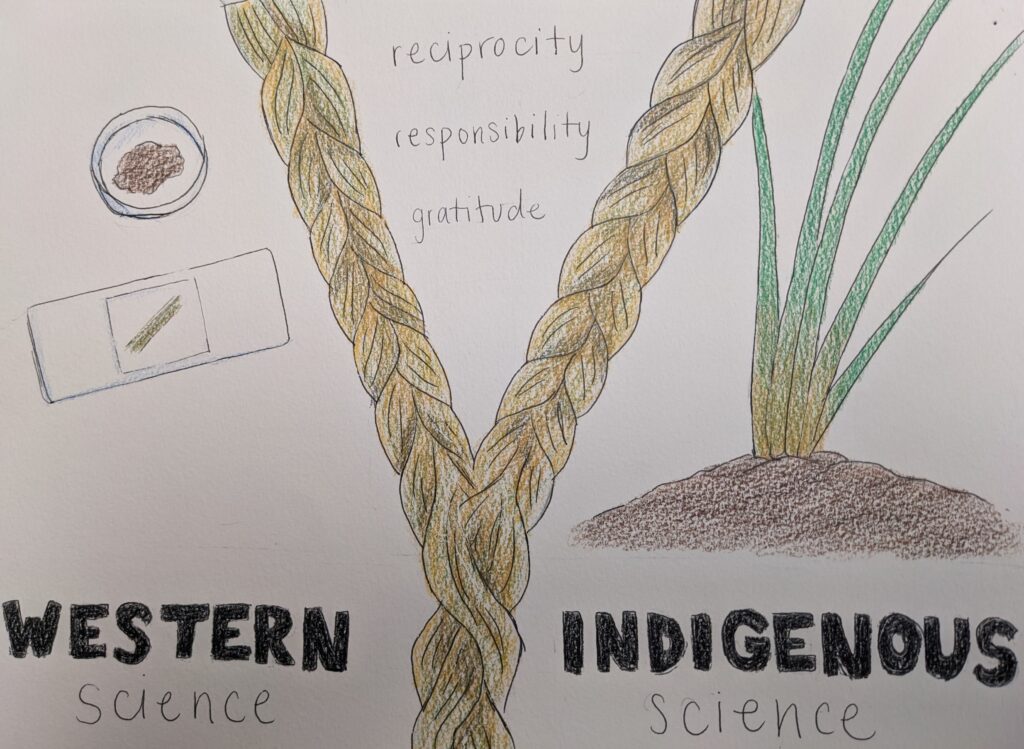Lynnea is one of this year’s Teacher Recognition award recipients at Camosun College, and like Pei Mei, she teaches in the English Language Development program. Lynnea has been at Camosun since 1985, starting as a substitute instructor for a faculty member who was ill, and continuing to pick up work until she was permanent.
Lynnea’s road to teaching ESL was circuitous. “I traveled to Asia with a singing group and every place I went, I was offered a job as an English teacher. And I thought, well, that’s curious. So, when I returned to Canada, I decided to apply for a Linguistics program and even though I was late with my application, I was accepted and suddenly there I was sitting in a linguistics class not knowing if I really wanted to be there.” Lynnea explained that one day a Camosun instructor by the name of Jamie Baird came to class and as he spoke about how you can give people dignity by teaching them to read a soup label or a street sign, Lynnea was moved to tears. By the time she went home that day, she knew she had decided to become an ESL teacher.
Lynnea says she generally teaches the intermediate ELD courses in BESL (Basic English as a Second Language) which she loves. “I have the world in my classroom, with both immigrants and international students which many colleges don’t have. We’ve had Fujian students from China, a group that came out of the Chechen war, a huge group from Panama, and even pilots from Vietnam who took English so they could fly Boeing airplanes. I love the variety of people I get to meet and work and learn with – you can have an 18-year-old from Japan and 75-year-old doctor or lawyer in the same classroom. I also enjoy seeing people who come in at one level of writing or speaking and, when they leave, have improved, whether it’s a small amount or by leaps and bounds. It is rewarding to see the confidence students gain as they improve.”
As I often do, I asked Lynnea what impact the last three years has had on her teaching. She started by telling me about her daughter who just graduated and in her valedictory speech recalled how their graduating class had spent all of their high school years under the pandemic (since it was only declared over May 5, 2023) and how much that changed them. For Lynnea and her students, the change was tremendous at the time of the lockdown. “Reading and writing online worked, but listening and speaking seemed ridiculous, but we still had to do it. I’m not a lover of technology although I can use it – I just prefer being face-to-face. Being online, for me, really reiterated the need to be together to learn.” But despite the frustrations, Lynnea, says “while I’m pretty flexible, I learned to be even more flexible and to think of creative ways to achieve my goals. I learned a lot about online teaching and what I like and don’t like about it. But while we did our best, the goalposts for student learning changed and that has been hard for us.”
I asked Lynnea if she has kept anything of what she learned teaching online during the pandemic, and while she at first said no, she amended that a little, saying “While I’ve always been pretty prolific on D2L, I definitely use the Assignments more, and while I stopped using Discussions for awhile, I am thinking about trying them again. I also feel more in control of how I organize my course materials on D2L, but most of my students’ learning now happens back in the classroom.” Lynnea feels the experience of the past three years has a lesson for us all, which I loved. “I have found in life that when you’re uncomfortable and stretched, you keep stretching and stretching and when you finally let go of the elastic, while it comes back to its original shape, it’s bigger. I think now we’re bigger because we’ve gained more skills and we’re able to do things more creatively than we could before.”
One of the things I am curious about when talking to faculty is what memories stand out for them over their years of teaching. Lynnea had three stories for me.
“Within my first five years of teaching, my classroom was upstairs, which was not usual. One of my students was a very tall older gentleman who struggled to get up to the classroom. One day I noticed he was out of breath so I sat down beside him and said, ‘Mr. Singh, can I ask you a question?’ And he said, ‘Oh, yes.’ I asked, ‘How old are you?’ And after a few minutes of not quite hearing his reply, I asked ‘Are you 89?’ And he said, ‘Yes, ma’am.’ We started talking and I found out he had been one of the leaders in the Pakistani Parliament, but here he was, so humble, and struggling to go up upstairs. The next morning, I asked for a new classroom, explaining that I had an almost 90-year-old student in my class, and the next night, we were in a downstairs room. I still remember him – he was the best student in the class and always had his work done on time and when I retire, he’ll stand out for me.”
Lynnea’s second memory is reflective of students who have come to Canada to escape their countries. “Recently, one of my recent Ukrainian students was a young married lady who came in very late one day to class. She apologized and said ‘I’ve been looking for my family and I couldn’t find them, and I’ve been on the phone all night. But I finally found them – my parents are alive.’ This was after a weekend of terrible bombing in Kiev. We all just looked at her and suddenly everything about being in that classroom didn’t matter, and I realized that while what we do in the classroom is important, it’s all temporary.”
And Lynnea’s third memory involved having Sherri Bell come into the classroom to talk to her students. From what she recalls, Lynnea told me “Sherri said something I have quoted so many times since. She asked the students, ‘How many of you don’t know what you want to do in the future?’ Most of them put their hands and then she said, ‘I want to tell you the story of my kids. I have a daughter who after high school went right away to university Calgary but realized quickly she’d made a mistake. She had the courage to finish the year, came back home, took some time, then went to Royal Roads and now has a job in Alberta with an insurance company and loves it. But my son didn’t know what he wanted to do so he didn’t go to school right away and waited a couple of years. When he realized he wanted to play basketball and the Chargers wanted him, he came to Camosun. Eventually he went to UBC and became a physiotherapist.’ She looked at my class and said, ‘Don’t be in a rush to go to school. Wait until you know what you want to do – if you’re not ready, take the time to figure it out.’”
After reflecting a bit on the many memories Lynnea has, I asked what advice she would give a new faculty member joining the ELD department. “For new teachers that come in ESL, I would just say be as creative as you can, and don’t be afraid to try new things in class. Have a plan but be fluid, and always have more than you need to pull from. Be funny and be entertaining – I sometimes feel like I’m like Jay Leno. We have fun and laugh a lot in my classes. And remember that it’s ok to make mistakes.” For Lynnea, it’s also about creating that community in the classroom. “Many students are afraid of teachers, but if we can have fun and build trust, in a few days we feel like a family.” Then she shared one more piece of advice which the woman who hired her shared: “She told me nothing is worth teaching if you only teach it once. Students need to have it pulled in every different direction: scaffold it, add more, teach it over and over so they remember it.”
Lynnea and I ended out conversation with Lynnea telling me what a privilege teaching people from all over the world is for her. “Even though I originally didn’t want to teach ESL, at the end I am so grateful to everyone who taught me and hired me and supported me. Every person I work with is amazing, and I am grateful for each single person I have the privilege of teaching.”

 This year, we recognize Charlie Molnar, Biology, for his work revising, adapting, and creating Open Educational Resources since 2015. Charlie began his Open Education journey by working with Dr. Jane Gair, another Camosun Biology instructor, to substantially revise the Open textbook, Concepts of Biology, creating the
This year, we recognize Charlie Molnar, Biology, for his work revising, adapting, and creating Open Educational Resources since 2015. Charlie began his Open Education journey by working with Dr. Jane Gair, another Camosun Biology instructor, to substantially revise the Open textbook, Concepts of Biology, creating the  Congratulations to 28 faculty from across Camosun College who are being recognized for their contribution to teaching and learning!
Congratulations to 28 faculty from across Camosun College who are being recognized for their contribution to teaching and learning!
